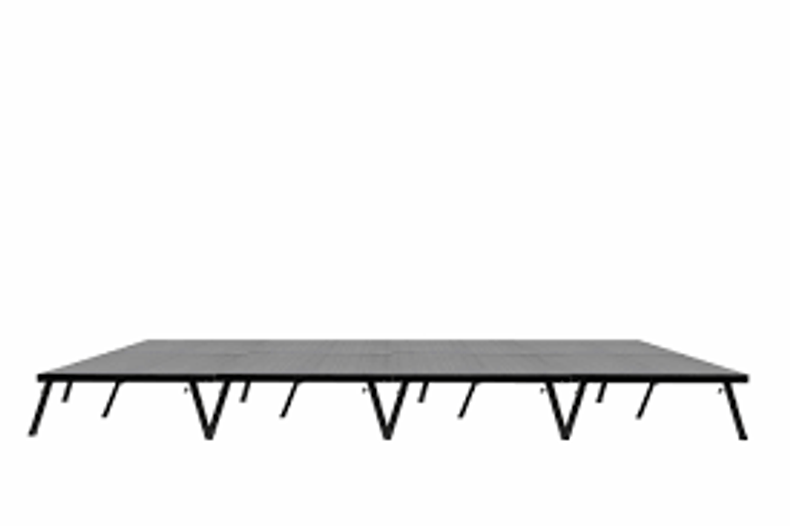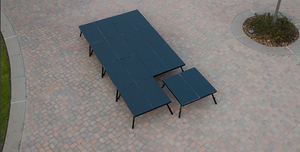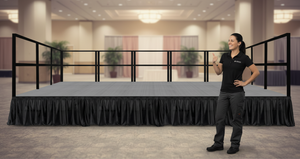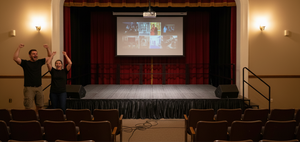Portable stages are the cornerstone of countless events, from intimate gatherings to grand performances. They provide a versatile platform for event organizers to elevate events and captivate their audience. Building your portable stage offers numerous advantages, including cost-effectiveness, customization, and the satisfaction of a DIY project.
This comprehensive guide will walk you through the entire process of creating a portable stage, from initial planning to the final touches depending on event sizes. We’ll cover everything from choosing the right materials to assembling the stage, ensuring safety, and proper maintenance. Whether you're an experienced DIY enthusiast or a novice event planner, this step-by-step approach will empower you to understand how to set up a portable stage for an event that perfectly suits your needs.
Let's get started!
Pre-Planning Your Stage Setup
Proper planning is essential for a successful portable stage build. By carefully considering factors like event size, audience, and location, you can ensure your portable staging solutions meet your needs and exceed expectations.
For instance, if you are planning for an outdoor event you'd need an outdoor stage setup.
Assessing Your Event Needs
Before embarking on your stage-building journey, carefully assess your event's specific requirements. Consider the aspects like type of event you're hosting, the expected size of the audience, the venue, and the nature of the performers involved.
It is critical to determine the ideal mobile stage dimensions and height to accommodate your needs while ensuring adequate visibility.
Equally important is evaluating the load-bearing capacity of the stage and the conditions of your event location, especially in outdoor events. This information will help you choose the right materials and construction methods to build a safe and sturdy platform.
Choosing the Right Portable Stage
Selecting the appropriate portable stage systems is crucial for a successful event. Common substances include aluminum for lightweight and durability, and wood for a classic and complete look. Consider factors such as the stage's intended use, weight capacity, and budget when making your choice. A durable stage with a long lifespan is generally a wise investment.
Don't forget about essential stage accessories. Handrails, stairs, extra space, easy storage, and covers not only enhance safety but also improve the stage's overall appearance and functionality. Investing in high-quality accessories can elevate your portable stage and create a professional look.
Gathering Necessary Equipment and Tools
Before starting your stage-building project, ensure you have the essential tools and materials. A saw, drill, screwdriver, and level are indispensable for construction. Depending on your event's requirements and chosen stage design, you'll need materials like wood, aluminum, or plywood. Fasteners such as screws, bolts, and nails will secure the structure.
Safety is paramount, so equip yourself with gloves, goggles, and protective footwear to prevent injuries. Proper preparation will streamline the building process and ensure a safe working environment when creating the portable stage.
Step-by-Step Guide to Building & Setting Up a Portable Stage
In this section, we share a detailed blueprint for constructing and erecting your portable stage on various surfaces. From assembling the frame to securing the mobile stage and adding finishing touches, follow these steps for a successful build.
Preparing the Location
In case of outdoor events before assembling your portable stage, prepare the ground for a stable base. Begin by leveling the surface to prevent unevenness that could compromise the stage's stability. Clear the area of debris, rocks, or any obstacles that might interfere with the construction of your outdoor stage.
Assembling the Stage
Constructing the mobile stage frame is the foundation of your build. Assemble the main frame using your chosen materials, ensuring square corners and even measurements. Reinforce the frame with cross supports for added stability.
Secure these supports with brackets or screws, ensuring they are firmly attached.
Once the frame is complete, it's time for the decking. Choose plywood or other suitable material for the stage surface. Cut the decking pieces to fit the frame precisely. Attach the decking securely to the frame using screws or nails, ensuring a level and even surface.
Consider adding additional layers of plywood for reinforcement if needed. Be extra careful when creating an outdoor portable stage for outdoor events such as a musical performance or concert.
In short,
- Level the surfaces for stability.
- Clear the area of debris and obstacles.
- Assess the ground's ability to support the stage's weight.
- Reinforce the ground if necessary (e.g., using plywood).
Securing and Stabilizing the Stage
A stable stage is crucial for safety and performance. Event organizers use anchors or weights to secure the stage to the ground, especially in windy conditions. Double-check that the stage is level to prevent accidents. Reinforce joints and connections with additional screws or brackets for extra stability.
Regularly inspect the stage for any signs of weakness or movement.
Adding Stage Accessories
Enhance your stage with essential accessories if you are working for an outdoor event. Adopting truss systems can be a great idea. Install sturdy handrails and steps for safe access, especially if the stage is elevated. Protect your stage investment with a weather-resistant cover when not in use.
To create the desired ambiance, incorporate lighting equipment, such as spotlights or LED strips, etc. For audio clarity, consider adding speakers and microphones. These additions will transform your stage into a professional performance space.
Tips for a Successful Stage Setup
Ensure your stage is not just built but optimized. Prioritize safety with proper setup and clear signage. Consider your audience's perspective and create a layout that enhances visibility.
Be prepared for challenges and have a plan to address potential issues. Proper planning and execution are key to a successful stage setup.
Ensuring Safety and Compliance
Prioritize safety by adhering to local building codes and regulations. Conduct thorough load tests to verify the stage's capacity to support performers and equipment. Communicate potential hazards with appropriate signage. Implement emergency procedures and provide first aid kits on-site. Regular inspections and maintenance are crucial to identify and address any safety concerns. Use portable stage platform railing for the safety of performers and audience.
Optimizing Stage Layout for Your Event
Careful stage installation is essential for a successful event. Consider the stage's orientation to maximize audience visibility and minimize distractions. Ensure ample space for performers to move freely and interact with the audience.
Strategically position equipment, such as speakers and lighting, to enhance the overall experience. Experiment with different layouts to find the perfect configuration for your event.
Troubleshooting Common Issues
Unexpected challenges can arise during stage setup. If your stage feels unstable, check for loose connections, uneven weight distribution, or inadequate support. For uneven ground, use leveling blocks or plywood to create a stable base. Damaged components, such as broken boards or loose screws, can compromise safety. Repair or replace damaged parts promptly. Regular inspections and preventive maintenance can minimize these issues.
Maintenance and Storage of Portable Stages
Ensure your stage is not just built but optimized. Prioritize safety with proper setup and clear signage. Consider your audience's perspective and focus on building a layout that enhances visibility. As event organizers be prepared for challenges and have a plan to address potential issues. Proper planning, implementing suggestions, and execution are key to a successful stage.
Cleaning and Maintenance Tips
Proper care extends lifespan of your portable stage for sale or for your event company’s use.
- Regularly clean the stage with mild detergent and water, inspecting for wear or damage.
- Protect your investment from weather elements by storing it in a dry, covered area when not in use.
- Lubricate moving parts like hinges and casters to ensure smooth operation.
Routine maintenance prevents costly repairs of resources and ensures your stage remains in optimal condition for future events
Proper Storage Solutions
To preserve your stage for future use, disassemble it carefully into manageable components. Protect your resources from damage by wrapping them in protective covers or padding. Choose a dry, clean, and well-ventilated storage room to prevent moisture damage and warping.
Consider using storage containers or racks to keep components organized and accessible. Proper storage ensures your stage remains in excellent condition for your next concert.
Conclusion
Building your stage offers numerous advantages, including cost-effectiveness, customization, and a sense of accomplishment. By following the steps outlined in this guide, you've gained the knowledge of how to build set up a portable stage for event. Be it an outdoor event or an indoor celebration truss is a great way to create a portable stage.
As experienced event planners you need to pay careful attention to details from pre-planning to maintenance, ensuring a successful build.
We encourage you to put these guidelines into practice and transform your event platforms. Remember, safety is paramount, so always prioritize stable resources and adhere to local regulations. With proper planning and execution, you'll be well-equipped to create unforgettable experiences for guests on your custom-built portable stage.
For additional support and inspiration, explore online forums and communities dedicated to stage building and event planning. Sharing experiences and learning from others can further enhance your stage-building journey.






